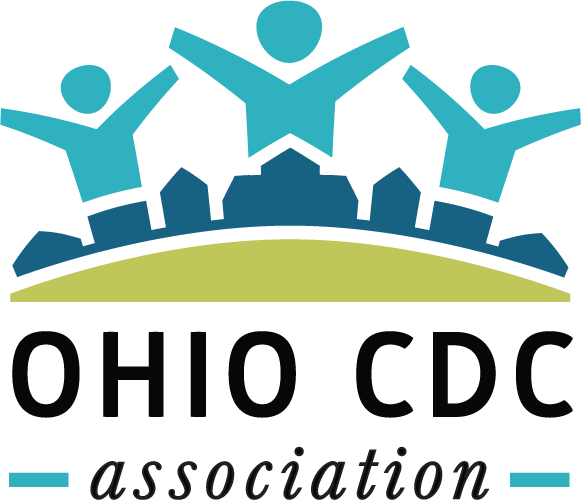Housing and Community Coalition
The Housing and Community Coalition is comprised of leaders in housing development, homelessness services, and community economic development, joined together to implement housing and community initiatives that will achieve long-term, sustainable recovery for Ohio’s hardest hit and most vulnerable populations.
The coalition is requesting a one-time $200 million investment of ARPA funds, which would represent a comprehensive and equitable approach to empower families and improve the quality of life in marginalized communities for the long term. Get involved.
Platform
Ohio Housing Trust Fund: $100 million ARPA appropriation
A single-family home developed by the Trumbull County Land Bank in Warren, Ohio.
Covid-19 highlighted the foundational importance of home. The Ohio Housing Trust Fund, the primary source of state funding for local housing and homelessness programs, helps build a stable foundation for healthier families, thriving communities, and a stronger workforce.
A one-time $100 million allocation of ARPA dollars to the Housing Trust Fund will enable local nonprofits in Ohio’s rural, urban, and suburban communities to:
Maintain and repair more homes for seniors and people with disabilities.
Increase development and preservation of affordable housing.
Prevent and end homelessness.
Investing $100 million in ARPA dollars into the Trust Fund will greatly expand access to safe, decent, affordable homes for:
Low-income seniors and people with disabilities who need home repairs and modifications to avoid institutionalization.
Transition age youth exiting foster care, jail, and detention.
Infants at risk of illness and death due to the lack of a home.
Ohioans struggling to overcome mental illness, addiction and homelessness.
People fleeing domestic violence who need safe housing.
Individuals annually caught in human trafficking.
Veterans experiencing homelessness.
Every Housing Trust Fund dollar invested leverages $3.19 in private, federal and local sources and generates $8.30 in overall economic activity for the state. Over 85,000 seniors and Ohioans with disabilities have avoided institutionalization, thanks to home repairs and modifications funded by the Housing Trust Fund.
Ohio has infrastructure, programs, and state/local partners poised to quickly deploy ARPA funding to significantly increase access to housing for Ohioans who were hardest hit by the pandemic. A year after the pandemic reached Ohio, we see more families sleeping in tents and cars, youth engaging in risky behaviors, and people with mental illness and addiction issues filling our jails and prisons. Meanwhile, increased materials and labor costs slowed the construction of affordable homes and hindered homeowners’ ability to perform critical home repairs. The homeless response system remains strained by increased demand and operational changes necessary for coronavirus-safe sheltering. It is clear we must act on this opportunity to use one-time funding to make housing investments that will serve a generation of Ohioans.
Rebuilding Ohio’s Communities: $100 million ARPA appropriation
A one-time $100 million allocation of ARPA dollars for existing and new community economic development programs will:
Empower Ohio’s families through housing, job creation, financial stability, and food security.
Fortify Ohio’s small businesses and Main Streets.
Ensure recovery is equitable across the state and within communities.
Campbell’s Market, Vinton County’s only grocery store, which came about through Healthy Food for Ohio.
Invest $100 million in ARPA dollars collectively into these community economic development initiatives:
Healthy Food for Ohio, which has created nearly 700 jobs and served nearly 150,000 people, with each $1 being leveraged by $5.
A re-established Clean Ohio “2.0” to accelerate redevelopment. The flexibility of the original Clean Ohio Revitalization Fund spurred transformative redevelopment projects across the state and generated $4.67 in new economic activity for every $1 spent by the state.
The Historic Preservation Tax Credit, which has rehabilitated 405 historic buildings and injected $4.05 billion into the economy in over 70 communities since 2008.
Ohio Main Street Grants, which support small independent businesses in our historic downtowns.
The Ohio Microbusiness Development Program, which fosters low- and moderate-income household business and self-employment development.
The Ohio Community Transformation Fund which would empower Community Development Financial Institutions (CDFIs) to increase support to vulnerable small businesses, protect and expand jobs, and increase redevelopment in low-income and underserved communities. Community Development Financial Institutions (CDFI) provide financing options that are more risk tolerant than traditional financing.
The Main Street Job Recovery Program, which will create employment opportunities, support small businesses, and increase self-sufficiency among low- to moderate-income Ohioans, while leveraging 10 - 20 times the investment in job creation and revitalization.
The Ohio Financial Empowerment Fund, which will support impactful financial education programs helping Ohioans access traditional banking, build assets, maintain housing, and be able to weather future challenges.
Targeted Neighborhood Homeownership Development, which will invest gap resources by rehabilitating distressed homes and will result in increased homeownership and a revitalized community, while removing blight vacancy, and abandonment.
As we think about recovery from the pandemic’s economic and health impacts, Ohio’s Main Streets, neighborhoods, businesses, employees, and residents will be the foundational building blocks to sustainably revitalize Ohio’s economy and communities.
Financial empowerment and asset building tools for struggling families will stabilize communities by fostering residents who are financially independent and stable.
Strong local food systems improve access to healthy foods, eliminate food deserts, and provide entrepreneurial and employment opportunities in the food economy.
Ohio’s historic downtowns and Main Streets are the heart of our communities where Ohioans gather, eat, shop, celebrate, and work. People and placed-based investments will recharge our communities’ cores and expedite Ohio’s recovery.
Investing in distressed communities will create springboards for their residents by bringing long-term solutions to the local community level. Ohio can blaze a new path forward that creates the environment for resilient, sustained empowerment that is long-term, and transformative.

